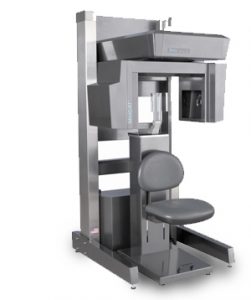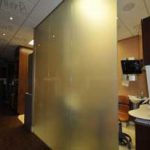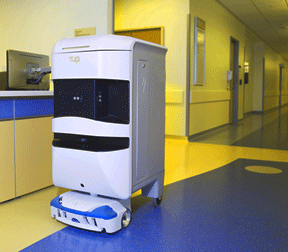 Imagine a computed tomography (CT) scanner that can be installed in a room as small as six by nine feet, weighs 450 pounds, and plugs into a standard electrical outlet. Well, for eye, ear, nose, and throat physicians it is possible to provide point-of-care CT imaging in a clinic or an operating room. The Xoran Technology’s MiniCAT™ is specially designed for head and neck imaging allowing physicians to diagnose and treat their patients faster and more conveniently. It creates high-resolution, ultra-thin CT slices (0.3 mm for temporal bones), making it ideal for scanning the sinuses, skull base, and temporal bones. The availability of a limited footprint, in-office, upright CT scanner enables point-of-care imaging without the problems associated with scheduling CT scans at the hospital’s central imaging department. A scan takes only 40 seconds to get an immediate, digitally versatile CT image on a Windows PC monitor.
Imagine a computed tomography (CT) scanner that can be installed in a room as small as six by nine feet, weighs 450 pounds, and plugs into a standard electrical outlet. Well, for eye, ear, nose, and throat physicians it is possible to provide point-of-care CT imaging in a clinic or an operating room. The Xoran Technology’s MiniCAT™ is specially designed for head and neck imaging allowing physicians to diagnose and treat their patients faster and more conveniently. It creates high-resolution, ultra-thin CT slices (0.3 mm for temporal bones), making it ideal for scanning the sinuses, skull base, and temporal bones. The availability of a limited footprint, in-office, upright CT scanner enables point-of-care imaging without the problems associated with scheduling CT scans at the hospital’s central imaging department. A scan takes only 40 seconds to get an immediate, digitally versatile CT image on a Windows PC monitor.
The actual dimensions of the unit are 46” x 49” x 72” tall. Although it can be installed in a room as small as 6’ x 9’, a room that is 80 to 100 net square feet is recommended, or the equivalent of the size of a standard exam room. The MiniCAT scanner emits very low radiation so that it requires little or no shielding to comply with State regulations. The manufacturer can install it in a single day since its small footprint fits through a standard door frame and it weighs only 450 pounds. The MiniCAT is compatible with most image-guided surgery systems and can also be used for surgical planning and post-operative evaluations and care.
 Ultrasound is a non-invasive procedure that used sound waves and a computer to create images of soft tissue structures such as muscles, blood vessels, and organs. It is used to diagnose a number of conditions that may not be adequately assessed with other imaging methods such as X-ray, CT, or MRI. GE Healthcare’s new compact Vivid™ ultrasound unit combines advanced imaging power in a rugged, portable, easily-cleanable, and light-weight (less than 10 pounds) unit that can be carried anywhere in the hospital or to an office-based physician practice. It is also capable of 2D transesophageal echocardiography (TEE) and intracardiac echo (ICE).
Ultrasound is a non-invasive procedure that used sound waves and a computer to create images of soft tissue structures such as muscles, blood vessels, and organs. It is used to diagnose a number of conditions that may not be adequately assessed with other imaging methods such as X-ray, CT, or MRI. GE Healthcare’s new compact Vivid™ ultrasound unit combines advanced imaging power in a rugged, portable, easily-cleanable, and light-weight (less than 10 pounds) unit that can be carried anywhere in the hospital or to an office-based physician practice. It is also capable of 2D transesophageal echocardiography (TEE) and intracardiac echo (ICE).
 Facilitating observation without compromising patient safety and privacy is a major challenge for hospitals. Curtains are used in many areas — including viewing walls of operating rooms, sliding doors in ICUs, and for windows between patient rooms and corridors — but they can become contaminated with drug-resistant bacteria and are difficult to sterilize. A new technology playing a pivotal role in providing observation without contamination and enhancing patient privacy is liquid crystal privacy glass. This electrically activated, switchable glazing technology instantly changes from transparent to frosted white, creating 100 percent privacy. It can be activated with a power button, remote control, or a smartphone as well as automatically using light and motion sensors. When in the powered state, the panels are clear, allowing full view and daylight to pass through. When unpowered, the view is completely obscured. Privacy glass is well suited to conference rooms, partitions, hospitals, front entrance ways, sidelights, toilet and bathrooms, and windows. It can also be installed alongside existing security glass or fire resistant glass panels to ensure maximum security and patient safety.
Facilitating observation without compromising patient safety and privacy is a major challenge for hospitals. Curtains are used in many areas — including viewing walls of operating rooms, sliding doors in ICUs, and for windows between patient rooms and corridors — but they can become contaminated with drug-resistant bacteria and are difficult to sterilize. A new technology playing a pivotal role in providing observation without contamination and enhancing patient privacy is liquid crystal privacy glass. This electrically activated, switchable glazing technology instantly changes from transparent to frosted white, creating 100 percent privacy. It can be activated with a power button, remote control, or a smartphone as well as automatically using light and motion sensors. When in the powered state, the panels are clear, allowing full view and daylight to pass through. When unpowered, the view is completely obscured. Privacy glass is well suited to conference rooms, partitions, hospitals, front entrance ways, sidelights, toilet and bathrooms, and windows. It can also be installed alongside existing security glass or fire resistant glass panels to ensure maximum security and patient safety. Imagine a computed tomography (CT) scanner that can be installed in a room as small as six by nine feet, weighs 450 pounds, and plugs into a standard electrical outlet. Well, for eye, ear, nose, and throat physicians it is possible to provide point-of-care CT imaging in a clinic or an operating room. The Xoran Technology’s MiniCAT™ is specially designed for head and neck imaging allowing physicians to diagnose and treat their patients faster and more conveniently. It creates high-resolution, ultra-thin CT slices (0.3 mm for temporal bones), making it ideal for scanning the sinuses, skull base, and temporal bones. The availability of a limited footprint, in-office, upright CT scanner enables point-of-care imaging without the problems associated with scheduling CT scans at the hospital’s central imaging department. A scan takes only 40 seconds to get an immediate, digitally versatile CT image on a Windows PC monitor.
Imagine a computed tomography (CT) scanner that can be installed in a room as small as six by nine feet, weighs 450 pounds, and plugs into a standard electrical outlet. Well, for eye, ear, nose, and throat physicians it is possible to provide point-of-care CT imaging in a clinic or an operating room. The Xoran Technology’s MiniCAT™ is specially designed for head and neck imaging allowing physicians to diagnose and treat their patients faster and more conveniently. It creates high-resolution, ultra-thin CT slices (0.3 mm for temporal bones), making it ideal for scanning the sinuses, skull base, and temporal bones. The availability of a limited footprint, in-office, upright CT scanner enables point-of-care imaging without the problems associated with scheduling CT scans at the hospital’s central imaging department. A scan takes only 40 seconds to get an immediate, digitally versatile CT image on a Windows PC monitor. The autonomous mobile TUG robots, developed by Aethon, work 24/7 to deliver drugs, laboratory specimens, supplies, linens and meals and cart away medical waste, soiled linens and trash at a variety of medical centers throughout the U.S.
The autonomous mobile TUG robots, developed by Aethon, work 24/7 to deliver drugs, laboratory specimens, supplies, linens and meals and cart away medical waste, soiled linens and trash at a variety of medical centers throughout the U.S. Every day, all around the world, hospital staff turn to a transport network that the Internet and the latest Silicon Valley wizardry cannot match — the pneumatic tube system. Designed primarily to move paper, this cutting edge technology in the 19th century drove commercial businesses — such as postal services and department stores — whose physical size demanded something faster than standard human pace. With the arrival of the Internet, pneumatic tube systems lost their value for many industries. But this technology not only endures — but thrives — in hospitals, particularly with the introduction of wider diameter containers and use of air flow to slow down the containers for a soft landing at their destination stations so to avoid damaging sensitive lab samples.
Every day, all around the world, hospital staff turn to a transport network that the Internet and the latest Silicon Valley wizardry cannot match — the pneumatic tube system. Designed primarily to move paper, this cutting edge technology in the 19th century drove commercial businesses — such as postal services and department stores — whose physical size demanded something faster than standard human pace. With the arrival of the Internet, pneumatic tube systems lost their value for many industries. But this technology not only endures — but thrives — in hospitals, particularly with the introduction of wider diameter containers and use of air flow to slow down the containers for a soft landing at their destination stations so to avoid damaging sensitive lab samples.